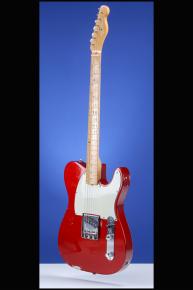Looks Like a '64 Esquire, But Sounds and Feels Like a '56…
This fifty-year-old Esquire went back to the Fender factory in 1964 where it was refinished in Candy Apple Red, fitted with a new then current "mint green" pickguard, and new (1964) potentiometers. It weighs just 7.20 lbs. and has a nut width of 1 5/8 inches and a scale length of 25 1/2 inches. Solid ash body and one-piece fretted maple neck with a huge '56 profile, 21 frets, and black dot position markers. Headstock decal with Fender "spaghetti" logo in silver with black trim and "Esquire" in black below it. "Transitional" single "butterfly" string tree (in the same position where the round string tree would be). Individual single-line "no-name" Kluson Deluxe tuners with oval metal buttons. The tuning keys are stamped "2356766/PAT. APPLD." on the bottom base. The neck is dated in pencil "5-56." The heel of the neck is stamped underneath "8 [or B] 3." On the guitar under the pickguard is stamped "C.A. Red/R R" and also the number "1" just below the "unused" neck pickup cavity. There is also a piece of the original factory tape in the "unused" neck pickup cavity which has the number "20" on it in pencil. Four-bolt neck plate with serial number ("10889") between the top two screws. One black six-polepiece "copper-coated metal plate bottom" pickup with staggered polepieces (angled in bridgeplate) and an output of 5.80k. Early '60s three-layer celluloid "mint green" pickguard with eight screws. Two controls (one volume, one tone) plus three-way "CRL 1452" "blender" switch and original Daka-Ware black plastic "Top-Hat" tip, all on metal plate adjoining pickguard. The potentiometers are stamped "304 6420" (Stackpole May 1964) and the three capacitors between the switch and the volume control are stamped "ZSW 1S5 .05MFD 150 VDC." Taller chrome knobs with rounded dome tops and knurled sides. Telecaster combined bridge/tailpiece with three 1/4-inch steel smooth saddles, the screws angled at 45 degrees. This guitar is in excellent plus (8.75) condition. There are a few chips to the finish on the edges, an area of playing wear on the lower back edge, a few small marks on the top, and some good old-fashioned wear to the maple fretboard, but with plenty of life left in the original frets. Housed in the original Fender "Tweed" hardshell case with brown leather ends and red plush lining (7.50)
"Leo Fender's new solidbody was the instrument that we know now as the Fender Telecaster, effectively the world's first commercially successful solidbody electric guitar...The guitar was originally named the Fender Esquire and then the Fender Broadcaster, and it first went into production in 1950. It was a simple, effective instrument. It had a basic, single-cutaway, solid slab of ash for a body, with a screwed-on maple neck. Everything was geared to easy production. It had a slanted pickup mounted into a steel bridge-plate carrying three adjustable bridge-saddles, and the body was finished in a yellowish color known as blond. It was unadorned and like nothing else. It was ahead of its time" (Tony Bacon, 50 Years of Fender, p. 10).
"After a false start the Esquire reappeared...in 1951, now with Fender's new adjustable truss-rod. It was offered in single-pickup format only, but otherwise was virtually identical to the two-pickup Telecaster. However, the Esquire's three-way selector functioned as a preset tone control or bypass switch, offering wide versatility from a one-pickup guitar. Perhaps surprisingly, the Esquire stayed in the line for 20 years" (Tony Bacon and Paul Day, The Fender Book, p. 10).
"Another Fender misconception is the 'big number stamp' seen on many custom color instruments. These large, 1/2" numbers are under the pickguard (on a body), and also usually on the heel of a neck (between the 4 bolt holes), stamped deeply in the wood. I've seen this on instruments as early as 1959, and as late as 1966. These large, stamped numbers sometimes denote a guitar as having some factory repair work, usually refinishing. The reason Fender used this stamp was very simple. Due to the large number of bodies and necks being painted at any one time, they had no way of keeping track of a particular guitar unless they marked it. If it was back for a refinish (a service Fender offered till the late 1960's), they would serialize the body and/or neck with this large, deep stamp. This allowed the guitar to be stripped and sanded without losing it's ownership. Then it could be put into the paint production system to be painted as if it was a new guitar. After the paint process was done, the large deeply stamped numbers would allow Fender to 'find' the refinished parts and re-assemble them, and ultimately return them to their owners" (http://www.provide.net/~cfh/fenderc.html).
Translate:








